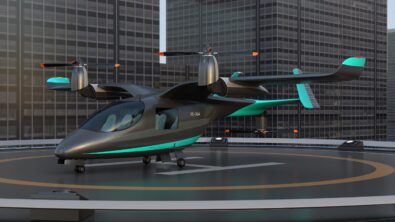Insights on AAM Autonomy from Automotive Part Three – Transcript

In this episode of Talking Aerospace Today, Todd Tuthill and Nand Kochhar conclude their discussion on what the advanced air mobility sector can learn from the automotive industry on vehicle autonomy. Together, they explore the role of digital transformation and what can get people using autonomous AAM.
Patty Russo: Greetings once again, and welcome to another episode of Talking Aerospace Today from Siemens Digital Industries Software. I’m Patty Russo and I manage global marketing for our aerospace and defense vertical here at Siemens. Thank you for tuning in today. Last time we continued our discussion on the challenges of autonomous flight in the advanced air mobility sector. Our experts Nand Kochhar, who’s our VP of Automotive and Transportation here at Siemens, and Todd Tuthill, our VP of Aerospace and Defense, shared what companies can learn from the automotive industries experience making their vehicles autonomous.
Patty Russo: Specifically, we covered important considerations related to autonomous technology, such as cybersecurity and certification. So now we’ll conclude the conversation on this topic, and I’d like to begin with a question for Nand. Nand. You also mentioned the idea of digital transformation and the level of maturity that perhaps an OEM is playing a factor. Overall, what role does this digital transformation play in development of autonomous vehicles, whether it be for an established OEM that has kind of the more traditional background versus companies that are more in the startup mode?
Nand Kochhar: Yeah, definitely. In fact, digital transformation is the key enabler. The reason I say that when we touched on autonomy, we talked about policy makers, we talked about the ownership and the insurance aspect of it. Once you take- and the users, whether they’re going to adapt it or not. So those factors. Once you take those out and put a pure technology view of it, digital transformation technology is the only and the key enabler. Within digital transformation, you have the digital twin that makes a very fundamental piece where you’re bringing physical, or some call it real world scenario, and the digital stereos together. That is very important in my experience of over 30 years working in the industry. I use an example engineers will understand in the audience.
Nand Kochhar: That correlation of test dissimulation is the key for engineers to make a decision whether we can progress offering that features with digital tools, or they still need to build some physical prototype and test. And that’s what we are calling digital twin, or one elements of digital twin technologies, which is part of digital transformation, is key. The other is bringing together all this work upfront, cross-domain. In the past, in the automotive industry, every vehicle had an architecture. In that case, architecture was a vehicle architecture. Hey, do you want your vehicle to be front wheel drive or rear wheel drive, or you want what kind of power pack, do you want a diesel or a battery powered? Etcetera. That was the definition of our architecture.
Nand Kochhar: But in today’s world it is not only the structure element and the architecture is important. It’s equally important to define the electrical architecture of the vehicles. It is equally important to define the software architecture. So now all that is possible to bring it all together through digital transformation technologies, you can bring what we call cross-domain. Mechanical, electrical, electronics and software. All these things together on top of bill of material of a given vehicle. And you can optimize not only for physical performance of the vehicles, but also from an efficiency standpoint, what kind of battery power might be needed. In fact and this is where it’s getting really exciting. What kind of computing power is needed in that vehicle and what power consumption that computing power will have.
Nand Kochhar: So this is an automotive call from chip [unintelligible] that in a vehicle, it’s not only about the just vehicle anymore. It is looking at the chip design, which goes in the vehicle, looking at the board system design which is in there, and then all the embedded software on that and the application software stacked on it. This is all coming together. So when we at Siemens talk about digital transformation, this is where the key differentiators we can bring, all these domains together up front for optimization. And then in the middle for development and the detailed design, and finally in the verification and validation of that design and that take that into service lifecycle management of that product. So that’s all, in my mind, all definitions of this is the transformation and that is why it is the single most important.
Patty Russo: Todd, I’m sure that you are nodding your head and thinking of all of the conversations of the past year or so that you’ve been having around digital transformation maturity and understanding how important it also is in aerospace. Comments from you related to what Nand just talked about in terms of the multidisciplinary approach and digital transformation maturity?
Todd Tuthill: Yeah, I want to echo a few things, Nand said because he said some very, very key things. When I think when a lot of us, and I’ll point to myself when I was in industry too. When you thought of digital transformation, our thoughts kind of immediately go to the front end design. And certainly digital transformation plays a huge role, has played a huge role and continues to play a huge role there. But Nand talked about going beyond that, you know, the comprehensive approach to digital transformation from the beginning to the end.
Todd Tuthill: Not just design, but in manufacturing in support, in sustainability, in all those things, and I encourage our listeners to think about that when they think about digital transformation. Don’t confine yourself to just the design aspect of digital transformation, but think about the broad aspects and that becomes more and more important. In aerospace and in advanced air mobility industry and specifically when you start to think about the key issue the industry is facing right now, which is lack of staffing and the need to multiply the impact of the current staff we have and it’s not just in design, but it’s throughout the whole process. And digital transformation can certainly help you do that.
Patty Russo: For sure. So we have talked quite a bit about lots of fun topics related to the autonomous vehicles, both in aerospace and defense and automotive were about a time. But before we conclude, I would like to ask the question that I like to ask at the end of these conversations. And that is, is there anything that Nand you would like to share or Todd that I have not prompted today that would be of interest to our audience who is interested in this autonomous vehicle topic?
Todd Tuthill: So if I could start, because I want to describe something and then end with a question for Nand, if I could around the same area. So when I think about this topic of uncrewed aircraft, question for our listeners and the question for Nand. What’s it going to take for you to climb into an aircraft that has no pilot? What’s your bar for, you know, for feeling safe, for feeling secure? Because I think that’s a key aspect of society for us to believe that that’s safe and be to convince that safe because the technology can be there and quite frankly, a lot of it’s already there today. But what’s it going to take from society impact?
Todd Tuthill: And I say think about that. It’s a thought exercise. And then my question for Nand is we’re already getting there in the automotive kind of area, and what do you think aerospace can learn from where automotive is already gone? Because you’ve already convincing people to get into those unmanned taxis. So from a society standpoint, what can we learn?
Nand Kochhar: Yeah, from a society standpoint, many, many different factors from human psychology to all the public relations and the legals and the policies and those kind of things. And I think the key important thing is people first have to feel comfortable about what they’re adopting. So the adoption rate of any technology is a slow moving curve and it comes along with many of those factors. I think one of the key things is showing those benefits and people have to adapt to those. In autonomous driving, when I talked about this for the first time, it was about 15 years ago or somewhere around that timeframe. I joked around and answering one of these questions by saying, “Hey, someday I’m going to get old. And they’re gonna take my driver’s license away. But I still want my. freedom. So I’m going to work on autonomy so by the time I get to that stage of my life, I’ll still have a freedom of movement.”
Nand Kochhar: Just think about that. So people, realizing the power. Now, it’s not only the age-related factors, but it is also autonomy and automotive is being talked about a lot of people are not capable of driving today for certain other reasons. So and people are using this in many, many different ways of thinking of it any different ways. Just imagine a lot of us have kids, and when they were growing up, how much driving around we were doing with taking them to different functions and schools. When you’re living in a fully autonomous environment, see what kind of burden it can take away from parents, right? It’s not only just soccer moms. But it’s dads, anybody, siblings who are driving people around when they’re not a drivable age. So these factors are huge. Some people who have vision issues today. So you see the freedom it’s opening. Right?
Nand Kochhar: And people have to realize that and see that, of course. It’s a big concern around safety. That is, I think where the technical side of the equation comes into play. I get passionate about it because today we are talking not only just autonomy, but we are talking about software-defined vehicles or software-defined products, and that is playing a big role in the AI journey, artificial intelligence, which has just started. And the generative AI is allowing pulling in all their driving information from every vehicle because now you have edge devices and the cameras, LIDARSs and those data is being transported back to the designs and learning from those scenarios, what’s going on and making every vehicle for tomorrow better than what it is doing today because it experiences all that learning and that gets adapted into the next generation of algorithms.
Nand Kochhar: So I think that maturity in my mind is continuing and that’s what gives me confidence that we’re gonna continue to grow levels of autonomy towards full autonomous vehicles.
Patty Russo: So Todd, again, I’m guessing your wheels are spinning and, another pun, I apologize. But the one last question I think is of interest, a rhetorical question as we’re wrapping our podcast today for the audience is, what will it take for you to get into an uncrewed aircraft just like you might have already done in an autonomous vehicle? So with that Todd, unless you have any other closing comments, we’ll wrap up this episode.
Todd Tuthill: Well, that sounds good. Patty, I can’t add anything better to what Nand just said. I thought that was a great summary to the whole driving need for autonomy.
Patty Russo: Outstanding. Well, thank you so much, Nand for joining us today. And Todd again for such an insightful discussion. Bringing industries together like this and sharing knowledge sharing experience is just so important and help us helps us all not only understand but helps our industries advance both ways, I think. Thanks also to our listeners for joining us again today. We’ll be back soon to talk about more facets of the burgeoning AAM sector in aerospace and defense. Once again, I’m Patty Russo and we look forward to having you back again for our next episode of Talking Aerospace Today.
Siemens Digital Industries Software helps organizations of all sizes digitally transform using software, hardware and services from the Siemens Xcelerator business platform. Siemens’ software and the comprehensive digital twin enable companies to optimize their design, engineering and manufacturing processes to turn today’s ideas into the sustainable products of the future. From chips to entire systems, from product to process, across all industries. Siemens Digital Industries Software – Accelerating transformation.


